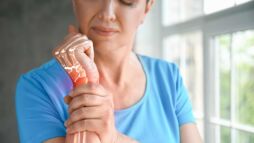Osteoporosis is a preventable disease
The term Osteoporosis originated from the Greek words, osteon meaning “bone” and porous meaning “hole”. In the modern daily use, osteoporosis signifies bone disease which is common in the elderly as well as postmenopausal women, which leads to increased risk of low-trauma fractures.
The National Institutes of Health (NIH) defined osteoporosis as “a disease of compromised bone strength, with bone strength made up of both bone mass and bone quality, resulting in an increased risk of fracture”
Osteoporosis is a silent disease
Osteoporosis is also known as the silent disease because it can develop gradually over the years without symptoms, until a fracture occurs.
Contrary to the notion that bone is an inert structure, our bones are metabolically active tissue which continuously remodels itself by breaking down old bone and replacing with new bone.
If the rate of bone loss exceeds bone formation, osteoporosis occurs.
Symptoms and risk factors of osteoporosis
Other symptoms which suggest osteoporosis may be stooped posture and decrease in height with aging. The leading causes of osteoporosis are age, gender (female gender) and genetic factors.
Other risk factors of suffering from osteoporosis is a previous history of low trauma facture, family history of hip fracture, early menopause and certain long standing diseases such as rheumatoid arthritis, thyroid diseases or other endocrine problems.
Do men or women have higher risk of osteoporosis?
Women tend to have higher risk of osteoporosis. Prior to menopause, female hormone oestrogen protect the body from excessive bone loss.
After menopause, there is a decline of this hormone, leading to rapid bone loss hence a more fragile skeletal system in post-menopausal women. Bone loss once developed is usually irreversible.
To maintain bone strength, it is essential for anyone, not just post-menopausal women, to have a healthy diet, maintain ideal body weight and engage in weight bearing exercises.
What are some factors that can reduce or aggravate osteoporosis?
Lifestyle behaviour modifications such as stop smoking, avoid excessive alcohol, minimise excessive salt in the diet as well as taking caffeine in moderation can help to reduce the chance of osteoporosis.
Long term consumption of certain medications such as steroids, thyroid medicines or anticoagulant (blood thinning) medicines can also accelerate bone loss.
When should prevention of osteoporosis begin?
Prevention of osteoporosis should begin during the age of thirties when there is a chance to attain a higher peak bone mass. Peak bone mass is the bone at its maximum strength and density.
Women’s bone will continue to deteriorate subsequently as bone loss tend to exceed bone formation after attaining the peak bone mass. In order to maximise the chance of achieving a higher peak bone mass, pre-menopausal women should have adequate calcium and vitamin D intake.
The recommended dose of daily calcium intake is 800-1000mg while that of vitamin D is 400 iu for premenopausal women. Post-menopausal women may need higher supplementation.
Weight bearing exercises such as jogging, running, brisk walking, sports and dancing can also help maintain agility, balance, muscle flexibility and maintain bone mass.
Consequences of osteoporosis
The devastating consequence of osteoporosis is fracture, especially of the hip and back. These fractures can render a person to be immobile or needing walking aids for ambulation.
The good news is that fractures can be preventable.
There are a numerous medications to delay osteoporosis or to maintain bone density. Each medication differs and has different modes of action on the bone with its attending side effect profiles.
With the elucidation of more pathways of bone metabolism, more medicines are expected on the horizon.
Ultimately, what is important is to know one’s risk of osteoporosis and fractures and there are numerous tools which can help the doctor to decide the best treatment strategy.

